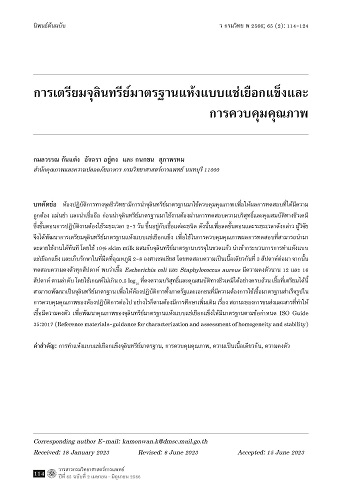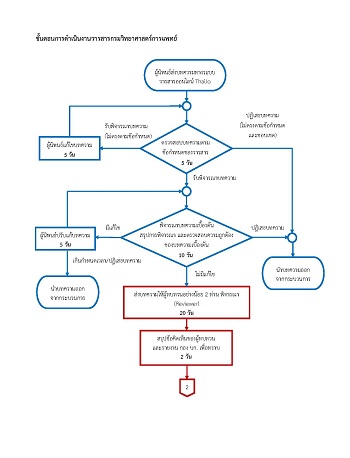การเตรียมจุลินทรีย์มาตรฐานแห้งแบบแช่เยือกแข็งและการควบคุมคุณภาพ
การเตรียมจุลินทรีย์มาตรฐานแห้งแบบแช่เยือกแข็งและการควบคุมคุณภาพ
คำสำคัญ:
การทำแห้งแบบแช่เยือกแข็งจุลินทรีย์มาตรฐาน, การควบคุมคุณภาพ, ความเป็นเนื้อเดียวกัน, ความคงตัวบทคัดย่อ
ห้องปฏิบัติการทางจุลชีววิทยามีการนำจุลินทรีย์มาตรฐานมาใช้ควบคุมคุณภาพ เพื่อให้ผลการทดสอบที่ได้มีความถูกต้อง แม่นยำ และน่าเชื่อถือ ก่อนนำจุลินทรีย์มาตรฐานมาใช้งานต้องผ่านการทดสอบความบริสุทธิ์และคุณสมบัติทางชีวเคมี ซึ่งขั้นตอนการปฏิบัติงานต้องใช้ระยะเวลา 2−7 วัน ขึ้นอยู่กับเชื้อแต่ละชนิด ดังนั้นเพื่อลดขั้นตอนและระยะเวลาดังกล่าว ผู้วิจัยจึงได้พัฒนาการเตรียมจุลินทรีย์มาตรฐานแห้งแบบแช่เยือกแข็ง เพื่อใช้ในการควบคุมคุณภาพผลการทดสอบที่สามารถนำมาละลายใช้งานได้ทันที โดยใช้ 10% skim milk ผสมกับจุลินทรีย์มาตรฐานบรรจุในขวดแก้ว นำเข้ากระบวนการการทำแห้งแบบแช่เยือกแข็ง และเก็บรักษาในที่มืดที่อุณหภูมิ 2−8 องศาเซลเซียส โดยทดสอบความเป็นเนื้อเดียวกันที่ 3 สัปดาห์ต่อมา จากนั้นทดสอบความคงตัวทุกสัปดาห์ พบว่าเชื้อ Escherichia coli และ Staphylococcus aureus มีความคงตัวนาน 12 และ 16 สัปดาห์ ตามลำดับ โดยใช้เกณฑ์ไม่เกิน 0.5 log10 ที่คงความบริสุทธิ์และคุณสมบัติทางชีวเคมีได้อย่างครบถ้วน เชื้อที่เตรียมได้นี้สามารถพัฒนาเป็นจุลินทรีย์มาตรฐาน เพื่อให้ห้องปฏิบัติการทั้งภาครัฐและเอกชนที่มีความต้องการใช้เชื้อมาตรฐานสำเร็จรูปในการควบคุมคุณภาพของห้องปฏิบัติการต่อไป อย่างไรก็ตามต้องมีการศึกษาเพิ่มเติม เรื่อง สถานะของการขนส่งและสารที่ทำให้เชื้อมีความคงตัว เพื่อพัฒนาคุณภาพของจุลินทรีย์มาตรฐานแห้งแบบแช่เยือกแข็งให้มีมาตรฐานตามข้อกำหนด ISO Guide 35:2017 (Reference materials−guidance for characterization and assessment of homogeneity and stability)
เอกสารอ้างอิง
Laboratory quality management systems. In: Salfinger Y, Tortorello ML, editors. Compendium of methods for the microbiological examination of foods. 5th ed. Washington, DC: American Public Health Association; 2015. p. 3−11.
ISO/IEC 17025:2017. General requirements for the competence of testing and calibration laboratories. Geneva: International Organization for Standardization; 2017.
Cabri. Preservation of bacteria by freezing and low temperature store below -70°C on glass beads. [online]. 1998; [cited 2020 Nov 9]; [2 screens]. Available from: URL: http://www.cabri.org/guidelines/micro-organisms/M300Ap505.html.
ISO 11133:2014/Amd 1:2018, Amd 2:2020. Microbiology of food, animal feed and waterpreparation, production, storage and performance testing of culture media - Amendment 1, 2. Geneva: International Organization for Standardization; 2020.
Research Randomizer. [online]. [cited 2020 Nov 9]; [2 screens]. Available from: URL: https://www.randomizer.org.
Culture methods for enumeration of microorganisms. In: Salfinger Y, Tortorello ML, editors. Compendium of methods for the microbiological examination of foods. 5th ed. Washington DC: American Public Health Association 2015. p. 75−87.
Mesophilic aerobic plate count. In: Salfinger Y, Tortorello ML, editors. Compendium of methods for the microbiological examination of foods. 5th ed. Washington DC: American Public Health Association; 2015. p. 95−101.
U.S. Food and Drug Administration. Bacteriological analytical manual (BAM) Chapter 12: Staphylococcus aureus. [online]. 2016; [cited 2021 Jan 14]; [6 screens]. Available from: URL: https://www.fda.gov/food/laboratorymethods-food/bam-staphylococcus-aureus.
U.S. Food and Drug Administration. Bacteriological analytical manual (BAM) Chapter 4: Enumeration of Escherichia coli and the coliform bacteria. [online]. 2020; [cited 2021 Apr 1]; [17 screens]. Available from: https://www.fda.gov/food/laboratory-methods-food/bam-4-enumeration-escherichia-coli-andcoliform-bacteria.
ISO GUIDE 35:2017. Reference materials-guidance for characterization and assessment of homogeneity and stability. Geneva: International Organization for Standardization; 2017.
ISO 13528:2022. Statistical methods for use in proficiency testing by interlaboratory comparison. Geneva: International Organization for Standardization; 2022.
ISO 19036:2019. Microbiology of the food chain-estimation of measurement uncertainty for quantitative determinations. Geneva: International Organization for Standardization; 2019.
ISO 22117:2019. Microbiology of the food chain-specific requirements and guidance for proficiency testing by interlaboratory comparison. Geneva: International Organization for Standardization; 2019.
ISO 16140-3:2021. Microbiology of the food chain-method validation-Part 3: protocol for the verification of reference methods and validated alternative methods in a single laboratory. Geneva: International Organization for Standardization; 2021.
นงลักษณ์ สุวรรณพินิจ, ปรีชา สุวรรณพินิจ. จุลชีววิทยาทั่วไป. กรุงเทพฯ: สำนักพิมพ์แห่งจุฬาลงกรณ์ มหาวิทยาลัย; 2544.
Differences between Gram positive and Gram negative bacteria. [online]. 2019; [cited 2019 Aug 14]; [26 screens]. Available from: URL: https://microbiologyinfo.com/differencesbetween-gram-positive-and-gram-negativebacteria/.

ดาวน์โหลด
เผยแพร่แล้ว
รูปแบบการอ้างอิง
ฉบับ
ประเภทบทความ
สัญญาอนุญาต
ลิขสิทธิ์ (c) 2023 วารสารกรมวิทยาศาสตร์การแพทย์

อนุญาตภายใต้เงื่อนไข Creative Commons Attribution-NonCommercial-NoDerivatives 4.0 International License.



